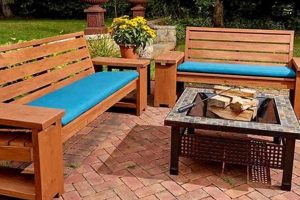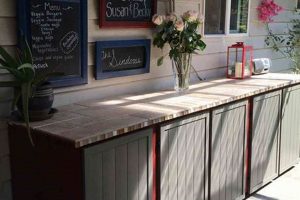The creation of exterior furnishings using repurposed wooden platforms represents a cost-effective and environmentally conscious approach to outdoor design. These platforms, commonly used in shipping and storage, can be disassembled and reconfigured into a variety of functional and aesthetically pleasing pieces. Examples include seating arrangements, tables, and even outdoor beds, all constructed from these readily available materials.
This method offers significant advantages, primarily in terms of affordability and sustainability. Utilizing discarded platforms reduces waste and minimizes the demand for new lumber, contributing to a more environmentally responsible lifestyle. Furthermore, the inherent rustic aesthetic of the wood adds character and charm to outdoor spaces. Historically, resourcefulness and the repurposing of materials have been essential aspects of both economic necessity and artistic expression.
The following sections will explore various aspects of creating outdoor furnishings from repurposed wooden platforms, including material selection and preparation, design considerations, construction techniques, and finishing methods. These will provide a comprehensive guide for those interested in undertaking such projects.
Essential Considerations for Pallet-Based Outdoor Furniture Construction
The following recommendations aim to optimize the durability, safety, and aesthetic appeal of outdoor furnishings crafted from repurposed wooden platforms.
Tip 1: Material Assessment is Crucial: Prior to initiating any construction, carefully inspect the wooden platforms for structural integrity. Decline platforms exhibiting signs of rot, excessive warping, or chemical contamination, indicated by labeling or staining. Employing sound materials ensures a stable and safe final product.
Tip 2: Prioritize Thorough Cleaning and Preparation: Meticulously clean each platform with a suitable detergent and scrub brush to remove dirt, debris, and potential contaminants. Allow the wood to dry completely before sanding. This step is critical for proper finishing and longevity.
Tip 3: Sanding is Essential for a Smooth Finish: Employ a power sander with varying grit levels to achieve a smooth surface. Begin with a coarse grit to remove imperfections, followed by progressively finer grits to refine the finish. Sanding enhances both the aesthetic appeal and the comfort of the furniture.
Tip 4: Utilize Appropriate Fasteners for Secure Assembly: Select exterior-grade screws or bolts specifically designed for outdoor use. These fasteners resist corrosion and provide a secure connection, ensuring the structural integrity of the furniture over time. Pre-drilling pilot holes prevents splitting the wood.
Tip 5: Apply a Protective Finish to Preserve the Wood: Apply a sealant, stain, or paint formulated for outdoor use to protect the wood from moisture, UV radiation, and insect infestation. Reapply the finish periodically to maintain its protective properties and extend the lifespan of the furniture.
Tip 6: Consider Ergonomics and Comfort in Design: Incorporate ergonomic principles into the design of seating and tables. Adjust seat heights, back angles, and table dimensions to promote comfort and usability. The addition of cushions or padding can further enhance comfort.
These considerations, when implemented diligently, will contribute significantly to the creation of durable, aesthetically pleasing, and safe outdoor furnishings from repurposed wooden platforms.
The subsequent sections will delve into specific design ideas and advanced construction techniques, building upon the fundamental principles outlined above.
1. Pallet Sourcing
The procurement of wooden platforms, commonly known as pallets, forms the foundational step in the creation of do-it-yourself outdoor furniture. The availability, quality, and type of pallets significantly impact the design, structural integrity, and overall viability of such projects. Effective sourcing strategies are therefore paramount.
- Identifying Pallet Types and Grades
Pallets are classified based on their construction materials, load-bearing capacity, and intended use. Standardized pallets, often marked with specific codes (e.g., EUR, EPAL), adhere to strict dimensions and quality controls. Unmarked pallets may vary considerably in construction and material quality. The choice of pallet type directly influences the suitability for specific furniture designs and the anticipated lifespan of the finished product.
- Locating Reliable Sources
Pallet acquisition can occur through various channels, including commercial businesses, recycling centers, and online marketplaces. Local businesses that receive frequent shipments are often willing to provide pallets at minimal or no cost. Recycling centers may offer pallets that have been inspected and refurbished. Online platforms facilitate the buying and selling of pallets in bulk. Selecting reliable sources ensures a consistent supply of quality materials and reduces the risk of acquiring damaged or contaminated pallets.
- Assessing Pallet Condition and Safety
Prior to utilization, each pallet must undergo a thorough inspection for structural defects, signs of decay, and potential contamination. Pallets that exhibit cracks, warping, or evidence of chemical spills should be rejected. Heat-treated pallets, indicated by the “HT” stamp, are generally safer for use than chemically treated pallets, marked with “MB” for methyl bromide. Prioritizing pallet safety minimizes the risk of structural failure and exposure to harmful substances.
- Legal and Environmental Considerations
While many pallets are freely available, it is essential to ascertain ownership rights before removing them from any location. Abandoned pallets may appear readily accessible, but taking them without permission constitutes theft. Furthermore, responsible pallet sourcing involves considering the environmental impact. Opting for recycled or refurbished pallets reduces the demand for new lumber and minimizes waste. Adherence to legal and environmental guidelines ensures responsible and sustainable pallet utilization.
The implications of pallet sourcing are far-reaching, influencing not only the aesthetic and functional characteristics of the final furniture pieces but also the economic and environmental sustainability of the entire project. Careful consideration of pallet types, sourcing methods, safety protocols, and legal requirements is essential for successfully creating durable and responsible outdoor furnishings from repurposed wooden platforms.
2. Structural Integrity
The concept of structural integrity is paramount in the context of do-it-yourself outdoor furniture constructed from repurposed wooden platforms. The inherent nature of pallet wood, often salvaged and of varying quality, necessitates careful evaluation to ensure the safety and longevity of the finished product. A lack of structural integrity poses significant risks, potentially leading to collapse, injury, and premature deterioration of the furniture. For example, utilizing a pallet with compromised support beams to build a bench could result in the bench’s failure under weight, leading to harm for the user. Therefore, understanding and addressing structural concerns represents a fundamental aspect of successful pallet-based furniture construction.
Several factors contribute to the structural integrity, or the lack thereof, in pallet-based furniture. The type of wood used, the presence of knots or cracks, the quality of the fasteners employed, and the overall design of the furniture all play critical roles. For instance, softwoods are more prone to warping and splitting than hardwoods, requiring more robust reinforcement in their construction. Similarly, using incorrect fasteners or failing to properly join sections together can create weak points that compromise the structural stability of the entire piece. Practical application involves a thorough assessment of each pallet prior to use, selecting sound materials, reinforcing weak areas with additional supports, and employing appropriate construction techniques such as proper jointing and secure fastening.
Ultimately, ensuring structural integrity in pallet-based outdoor furniture transcends mere aesthetics or cost savings. It directly impacts the safety and usability of the furniture and contributes to its long-term sustainability. While the process may present challenges in terms of material selection and construction techniques, the understanding and implementation of sound structural principles are essential for transforming discarded wooden platforms into durable and functional outdoor furnishings. Addressing these concerns proactively mitigates risks and fosters a responsible approach to do-it-yourself furniture construction.
3. Design Adaptability
Design adaptability, in the context of do-it-yourself outdoor furniture constructed from repurposed wooden platforms, refers to the capacity to modify and customize furniture designs to accommodate various spatial constraints, functional requirements, and aesthetic preferences. This adaptability is a crucial advantage of utilizing pallets, transforming readily available materials into bespoke outdoor furnishings.
- Spatial Accommodation
Outdoor spaces vary considerably in size and configuration. Design adaptability allows for the creation of furniture that precisely fits available areas, optimizing space utilization. For example, a narrow balcony might necessitate a compact seating arrangement, while a sprawling patio can accommodate larger sectional sofas and dining sets constructed from interconnected pallets. Adaptable designs circumvent the limitations of pre-fabricated furniture sizes.
- Functional Customization
Different outdoor activities necessitate distinct furniture types. Design adaptability facilitates the creation of pieces tailored to specific needs. A gardener might require a potting bench with integrated storage, while an entertainer may prioritize a bar area with ample counter space. Modular pallet designs enable the incorporation of these functional elements, creating highly personalized outdoor living spaces.
- Aesthetic Personalization
Individual aesthetic preferences vary widely. Design adaptability enables the expression of personal style through choice of finishes, configurations, and decorative elements. Pallets can be stained, painted, or left in their natural state to complement existing outdoor dcor. Unique arrangements and embellishments further contribute to the creation of personalized outdoor environments.
- Budgetary Flexibility
Financial constraints often influence furniture selection. Design adaptability allows for a phased approach to furniture construction, adding elements as budget allows. A basic seating arrangement can be expanded incrementally to incorporate additional features, spreading the cost over time. Utilizing repurposed pallets also minimizes material expenses, offering a cost-effective alternative to purchasing new furniture.
The interplay between spatial accommodation, functional customization, aesthetic personalization, and budgetary flexibility underscores the significance of design adaptability in the realm of do-it-yourself outdoor furniture created from repurposed wooden platforms. This adaptability distinguishes pallet furniture from mass-produced alternatives, transforming readily available materials into uniquely tailored outdoor living solutions.
4. Protective Finishing
Protective finishing represents a critical component in the successful creation of do-it-yourself outdoor furniture constructed from repurposed wooden platforms. The inherent properties of wood, particularly when exposed to external elements, render it susceptible to degradation. Moisture absorption leads to swelling, warping, and eventual rot. Ultraviolet radiation causes fading and embrittlement. Insect infestations can compromise structural integrity. Protective finishing acts as a barrier against these detrimental effects, extending the lifespan and preserving the aesthetic appeal of the furniture. Without adequate protection, pallet furniture will deteriorate rapidly, negating the economic and environmental benefits of repurposing. Consider a pallet bench left untreated; within a single season, it might exhibit discoloration, surface cracks, and even the beginnings of decay, rendering it unsightly and unsafe.
The selection of an appropriate protective finish necessitates careful consideration of the specific wood type, the intended use of the furniture, and the prevailing climate. Oil-based finishes penetrate the wood, providing water resistance and highlighting the natural grain. Water-based finishes offer good UV protection and are environmentally friendlier, while varnishes provide a durable, glossy surface. Proper application techniques, including thorough surface preparation and multiple coats, are essential for optimal performance. For instance, a wooden pallet table intended for dining should be finished with a food-safe sealant to prevent contamination. Similarly, furniture exposed to direct sunlight benefits from a UV-resistant coating to minimize fading. Regular maintenance, such as reapplication of the finish every one to two years, further enhances its protective capabilities.
In conclusion, protective finishing is not merely an optional embellishment but an indispensable aspect of constructing durable and long-lasting outdoor furniture from repurposed wooden platforms. Its application mitigates the damaging effects of the environment, ensuring the furniture’s longevity and preserving its aesthetic qualities. The understanding of appropriate finishing techniques and materials transforms a potentially short-lived project into a sustainable and aesthetically pleasing addition to any outdoor space, representing a crucial link in the successful execution of do-it-yourself pallet furniture projects.
5. Ergonomic Comfort
Ergonomic comfort, the science of designing for human efficiency and well-being, presents a significant consideration in the context of do-it-yourself outdoor furniture constructed from repurposed wooden platforms. Pallets, originally intended for material transport, do not inherently possess features conducive to human comfort. Therefore, achieving ergonomic comfort requires deliberate planning and execution throughout the design and construction phases. Neglecting this aspect can lead to furniture that is aesthetically pleasing but functionally unsuitable for extended use. For example, a pallet bench with insufficient seat depth or an improperly angled backrest may cause discomfort and discourage prolonged seating. Consequently, integrating ergonomic principles is not merely an aesthetic enhancement but a fundamental requirement for creating functional and enjoyable outdoor furniture.
Several practical modifications can enhance ergonomic comfort in pallet furniture. Sanding rough surfaces eliminates splinters and reduces friction against the skin. Adding cushions or padding provides cushioning and support, mitigating pressure points. Adjusting seat heights and back angles promotes proper posture and reduces strain on the back and neck. The inclusion of armrests offers additional support and comfort. Furthermore, the arrangement of furniture pieces can influence usability. Creating conversation areas that facilitate interaction and positioning furniture to take advantage of natural shade can contribute to a more comfortable outdoor experience. Consider a pallet lounge chair designed with an adjustable backrest and strategically placed cushions to support the lumbar region; this demonstrates a direct application of ergonomic principles for enhanced user comfort.
In summary, ergonomic comfort is a crucial determinant of the overall success of do-it-yourself outdoor furniture projects utilizing repurposed wooden platforms. By consciously incorporating ergonomic considerations into the design and construction process, it transforms otherwise utilitarian materials into functional and comfortable outdoor furnishings. While achieving optimal ergonomic design with pallets may present challenges, the resulting improvements in user well-being and furniture usability are well worth the effort, ultimately promoting sustained enjoyment of outdoor spaces. Prioritizing comfort guarantees the finished item is not only visually appealing but also practical and well-suited for its intended function.
6. Cost Effectiveness
The inherent allure of constructing outdoor furniture from repurposed wooden platforms resides significantly in its cost-effectiveness. Conventional retail furniture options often present substantial financial investments. Utilizing salvaged pallets provides a compelling alternative, drastically reducing material expenses. The primary cost drivers associated with this do-it-yourself approach typically include fasteners (screws, nails), finishing materials (stain, sealant), and potentially cushioning or fabric. These outlays generally remain significantly lower than the purchase price of commercially produced outdoor furniture sets. For example, a complete outdoor seating arrangement crafted from pallets might cost less than one-quarter the price of an equivalent set purchased from a furniture retailer. This substantial cost differential renders the approach particularly attractive to individuals operating with limited budgets or those seeking economical means of furnishing outdoor spaces.
The magnitude of cost savings varies depending on several factors, including the availability of free or low-cost pallets, the complexity of the design, and the selection of finishing materials. Individuals able to procure pallets at no cost, perhaps from local businesses or construction sites, maximize the potential cost benefits. Simpler designs require fewer materials and less labor, further minimizing expenses. Opting for budget-friendly finishes, such as basic sealants, rather than premium stains, also contributes to cost containment. The inherent adaptability of pallet-based construction allows for a phased approach, where components can be added incrementally as financial resources permit. Such flexibility enables individuals to create customized outdoor spaces without incurring significant upfront expenses, providing a distinct advantage compared to purchasing complete furniture sets.
In summary, the connection between cost-effectiveness and the construction of outdoor furniture from repurposed wooden platforms is a fundamental driver of its popularity. The potential for substantial savings, coupled with the adaptability of the materials, presents a compelling alternative to traditional retail options. While careful planning and labor are required, the financial benefits, combined with the environmental advantages of repurposing, render this approach an attractive and economically responsible means of furnishing outdoor environments. This is especially true when budget is a determining factor in furnishing an outdoor space.
Frequently Asked Questions
The following addresses common inquiries and misconceptions regarding the construction of outdoor furniture utilizing repurposed wooden platforms. The aim is to provide clear, concise information to facilitate informed decision-making.
Question 1: What are the primary risks associated with using pallets for outdoor furniture construction?
Potential risks include exposure to treated wood chemicals (e.g., methyl bromide), structural instability due to hidden damage or decay, and the presence of embedded foreign objects (e.g., nails, staples). Thorough inspection and appropriate safety precautions are essential.
Question 2: How can the presence of harmful chemicals in pallets be identified and mitigated?
Pallets marked with “MB” indicate treatment with methyl bromide, a highly toxic fumigant. These pallets should be avoided. Heat-treated (“HT”) pallets are generally safer. Sanding and sealing can further reduce potential exposure.
Question 3: What types of wood are most suitable for outdoor pallet furniture?
Hardwoods, such as oak and maple, offer greater durability and resistance to decay compared to softwoods. However, any wood type intended for outdoor use requires proper sealing and maintenance.
Question 4: What are the key considerations for ensuring the structural integrity of pallet furniture?
Thoroughly inspect each pallet for cracks, warping, and rot. Reinforce weak points with additional supports. Utilize exterior-grade fasteners and ensure proper joint construction. Prioritize weight distribution and stability in the design.
Question 5: How can the longevity of pallet-based outdoor furniture be maximized?
Apply a high-quality sealant, stain, or paint specifically formulated for outdoor use. Reapply the finish periodically, typically every one to two years. Cover the furniture during periods of inclement weather or non-use.
Question 6: Are there any legal or ethical considerations regarding pallet acquisition?
Obtain permission before removing pallets from any location. Taking pallets without consent constitutes theft. Prioritize the use of recycled or refurbished pallets to minimize environmental impact.
In summary, the successful creation of safe and durable outdoor furniture from repurposed wooden platforms requires careful planning, diligent execution, and adherence to safety protocols. The information provided addresses key concerns and promotes responsible practices.
The subsequent sections will explore design variations and advanced construction techniques for those seeking to further enhance their pallet-based furniture projects.
Conclusion
This exploration of diy outdoor furniture with pallets has illuminated critical aspects of this construction method. From material sourcing and structural considerations to design adaptability, protective finishing, ergonomic comfort, and cost-effectiveness, each element plays a vital role in the creation of functional and aesthetically pleasing outdoor furnishings. The successful implementation of these principles translates directly to furniture that is not only visually appealing but also durable, safe, and sustainable.
The informed application of these guidelines allows individuals to transform discarded wooden platforms into valuable assets. The long-term viability of these projects hinges on diligent planning, careful execution, and a commitment to responsible practices. Continued innovation in design and construction techniques promises to further enhance the potential of repurposed pallets in the realm of outdoor living.







